In Austin we will gather
to learn and talk and eat.
We love the session speakers
The Tech Show can't be beat.
We all revere the paddle, Godzilla and the rest
But singing in the song fest is what we love the best.
(From SHARE Songbook Song 226 to the tune of Yellow Rose of Texas)
Seventy years. Can you believe that’s how long SHARE has been around? Founded in August 1955, we predate the IBM System/360 by nine years — and had a lot to do with its gestation!
During the first 55 years of SHARE’s existence, a great deal of culture emerged, was developed, and even lasted quite a while. And while some of it appears to have migrated to secondary storage in recent years, there are many people and archives that still retain the culture and its artifacts, such as the songbooks and paddles (see below), ready for any reemergence and/or resurgence whenever the right occasion arises.
One such locus is the SHARE Archives Project, headed by SHARE Past President Anne Caluori. She is the steward of many physical and electronic artifacts, some of which I’ve been there to see her receive. One piece that comes to mind is a first issue of Cheryl Watson’s “Tuning Letter,” a highly respected publication that she initiated for those whose responsibilities include tuning the technical performance of the IBM mainframe. I asked Cheryl to autograph it when I donated it to the archives at the 2014 SHARE Pittsburgh meeting, as seen in the below picture.

Caption: Cheryl Watson signing the “Tuning Letter”
As you may imagine, Caluori is a SHARE historian and has a wealth of insight about SHARE’s cultural artifacts, including the songbook and the paddles.
The songbook, which contains within it a history of its creation and development, had its earliest formal beginnings a mere six years after IBM announced the System/360 mainframe. To quote the introduction, “In the spring of 1970 in New York, the singalong appeared for the first time in the SHARE agenda under the title ‘HASP Project Esprit de Corps.’” Appropriately, the first song sung at every such session since has been “HASPy Days are Here Again” (song number 12 in the songbook).
The songbook implicitly came into being as soon as there were songs to collect. According to a presentation by Caluori, the singalong had already emerged as an unofficial event, with informal singing around a ballroom piano in the late 1960s at SCIDS. Mary Anne Knutson elaborates on this history in a 2013 SHARE’d Intelligence article.
Hmmm. I think this article will need a glossary. I recommend the one by Mike Cowlishaw (IBM Fellow emeritus who invented the REXX programming language), available at the Havant Civic Society. It even has SCIDS (a nickname for the Thursday evening reception) in it!
The songbook contains a whimsical, musical history of the mainframe from the earliest days right up until 2009, when the last edition was produced. At that point, the singalong was soon to be stabilized, and helen seren (a very active SHARE volunteer, including Secretary on the Board, who worked for the University of Chicago until her retirement, and who chose not to capitalize her name, pictured below in a JES2 singalong shirt) designated me her successor as owner of the songbook, so I have the official Word document in addition to the PDF, the latter of which I’m glad to share upon request.
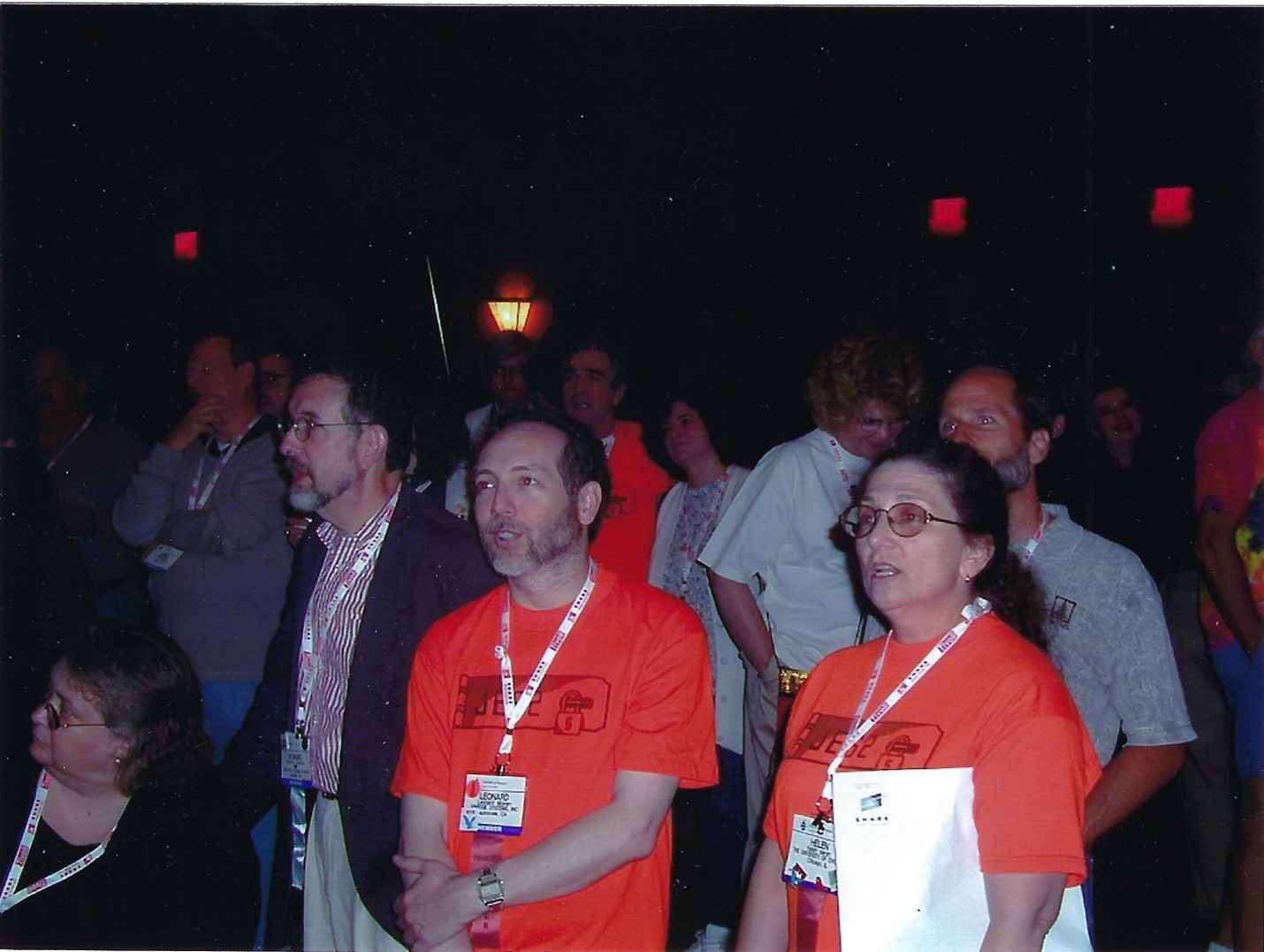 Caption: helen seren and others, in her SHARE singalong shirt at SCIDS
Caption: helen seren and others, in her SHARE singalong shirt at SCIDS
The songs themselves are just new words to old favorite tunes, some of which may still be recognizable. The technologies they refer to are often even more historical than the tunes now.
Not that long ago, SHARE held a Thursday evening reception with a JES2-sponsored activity, nicknamed the “JES2 Singalong.” We’d pull out our songbooks and/or watch the words projected on a screen above the stage, and someone would play the keyboard — usually a piano supplied by the hotel but nicknamed the “Model 88” (because of the 88 keys on the keyboard). In the below picture, Caluori is shown as the keyboardist:
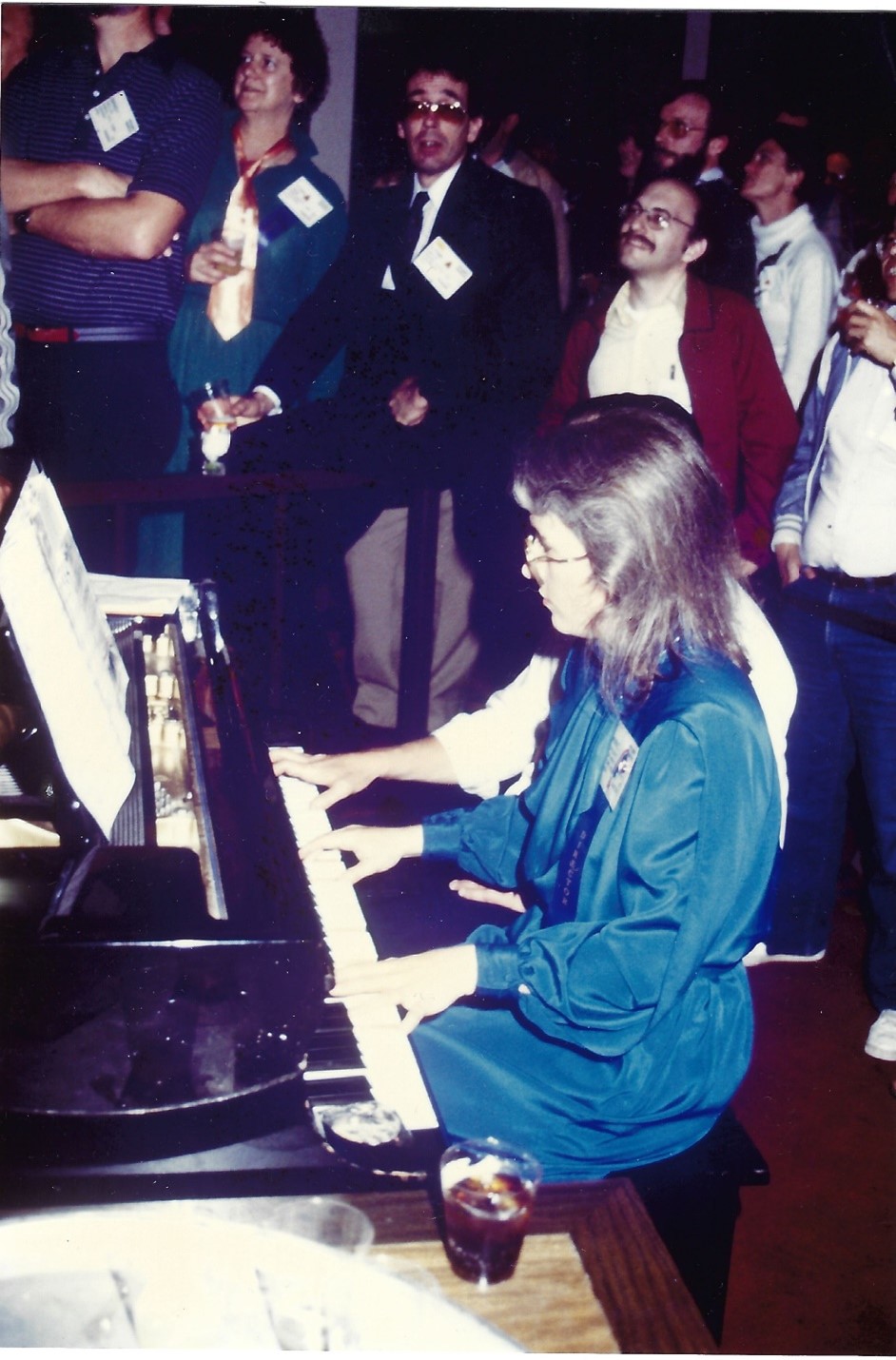 Caption: Anne Caluori at JES2 Singalong
Caption: Anne Caluori at JES2 Singalong
And some of us would take on the role of song leaders, if not exactly choir members — more like a chorus line — and get up on the stage and link arms while holding the paddles aloft, and sing. This is a tradition that was still going strong as recently as the March 2012 SHARE in Anaheim, according to then-Vice President Al Williams. Here is a picture from the last millennium with six SHARE past presidents forming the chorus line.
 Caption: Six SHARE past presidents: (left-to-right) John Hogan, Cecilia Cowles, Sandy Moy, John Chapman, Mike Armstrong, and Fred Jenkins
Caption: Six SHARE past presidents: (left-to-right) John Hogan, Cecilia Cowles, Sandy Moy, John Chapman, Mike Armstrong, and Fred Jenkins
Now, the paddles. You might wonder what these important pieces of SHARE history are.
According to Jim Marshall in a 2023 post on IBM-MAIN (login required), the origins of the paddles began with IBM announcing in the mid-1970s that the OS/MVT operating system would become unsupported. This led Dr. Robert Rannie of Northern Illinois University (NIU) to form the Paddle Project and create the mascot — an oar — a sign that IBM had left them “up a creek without a paddle.”
IBM’s earliest computers did not come with a full set of software, and it was up to the customers to figure that out, according to Janet Sun, SHARE past president. This is one of the reasons that SHARE came into existence and the early members worked together. SHARE published an early operating system called SOS for SHARE Operating System for some of these computers. Given this background, by the time that the paddles and singalong emerged, the fact that IBM was now providing operating systems and other software gave SHARE members one more dimension of input to offer IBM in response to apparent opportunities for improvement.
Included here are some pictures of the singalong at some 20th century SHAREs courtesy of Caluori, followed by pictures from the August 2007 SHARE in San Diego with some of us variously singing and holding the paddles.
 Caption: SHARE singalong in 1990s, with Dr. Robert Rannie in the blue shirt holding a paddle, and Jerry Feinman wearing the red cape.
Caption: SHARE singalong in 1990s, with Dr. Robert Rannie in the blue shirt holding a paddle, and Jerry Feinman wearing the red cape.
There are three paddles: a wooden one that has been broken in half and repaired, is covered in stickers, and has something like a guitar strap attached to it that is covered in buttons. Then there’s the second wooden paddle that is unharmed and has stickers and a button-laden strap. Then there is the clear acrylic “virtual” paddle that only has a small number of stickers. You can see all three in this picture from the February 2008 SHARE in Orlando.
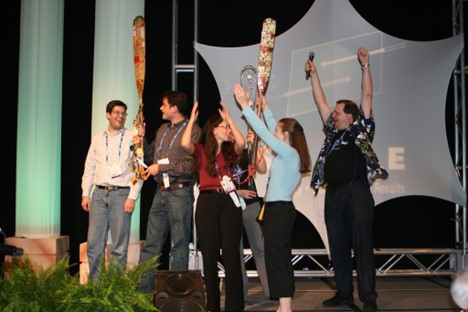 Caption: SHARE singalong in Orlando in 2008. Mike Todd of IBM is holding the leftmost paddle. Iris Rivera, cofounder and IBM rep of zNextGen, Kristine Bastin (then Harper), cofounder and president of zNextGen, and Reg Harbeck (author) are also in the picture.
Caption: SHARE singalong in Orlando in 2008. Mike Todd of IBM is holding the leftmost paddle. Iris Rivera, cofounder and IBM rep of zNextGen, Kristine Bastin (then Harper), cofounder and president of zNextGen, and Reg Harbeck (author) are also in the picture.
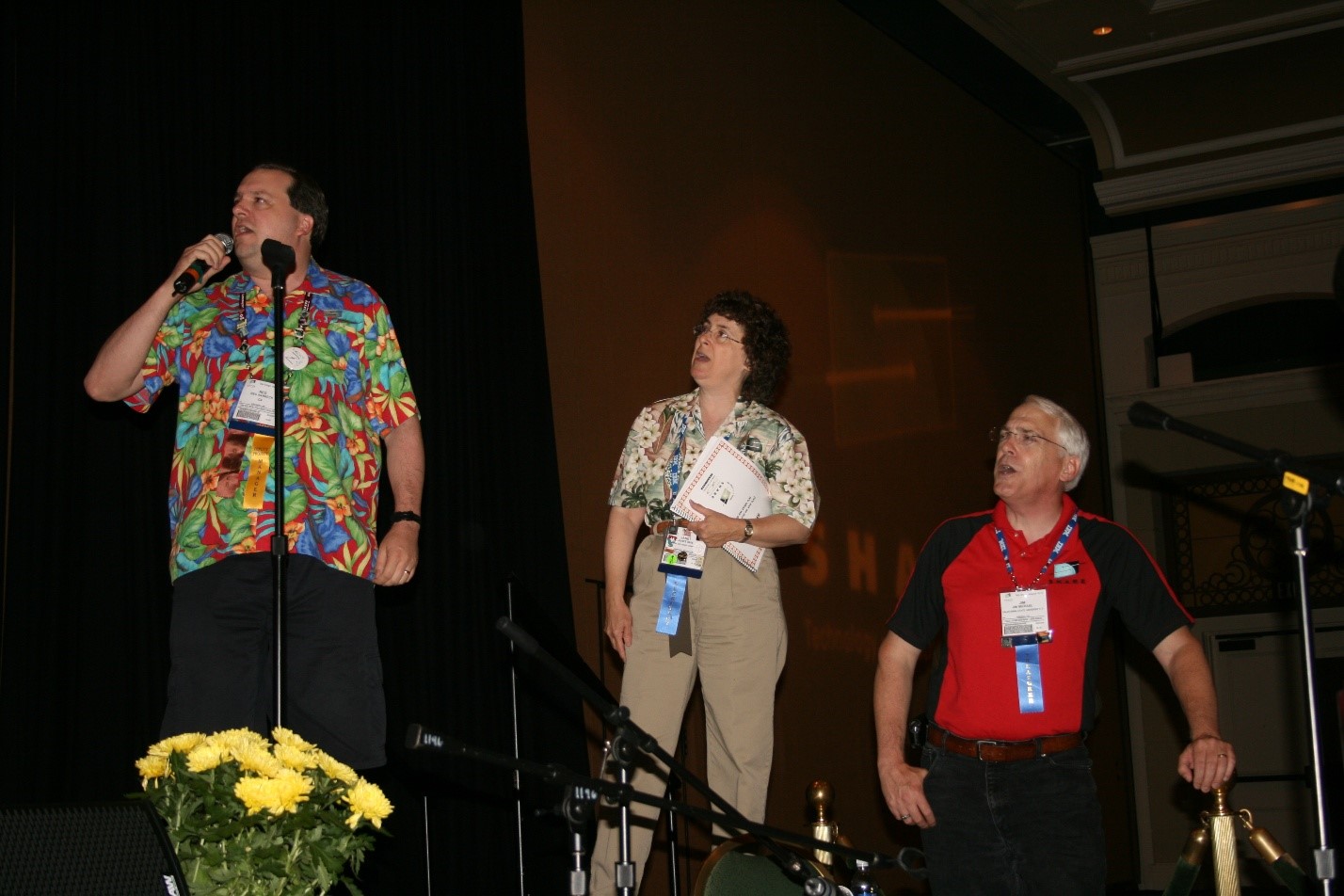 Caption: Reg Harbeck, Janet Sun (now past president of SHARE and SHARE Editorial Advisory Committee member), Jim Michael, now-former SHARE vice president, mentor of zNextGen, and original purveyor of these pictures, engaged in song at SHARE Orlando
Caption: Reg Harbeck, Janet Sun (now past president of SHARE and SHARE Editorial Advisory Committee member), Jim Michael, now-former SHARE vice president, mentor of zNextGen, and original purveyor of these pictures, engaged in song at SHARE Orlando
At a subsequent SHARE, IBM representative Jerry Feinman humorously leapt on the stage, took the paddle from Dr. Rannie, and broke it over his knee signifying that when OS/MVT would break, IBM would not assist in fixing it. The ever-resourceful Dr. Rannie took the paddle back home and created an APAR and a PTF (paddle temporary fix). He drilled holes in each end and inserted a titanium rod and used epoxy; it was now good as new, though looking like it had been fixed. Apparently, it had been sufficiently fixed, because when the same IBM rep tried to break it again, he limped off the stage. As the below picture illustrates, Dr. Rannie (left) and Feinman (right) actually got along quite well and were enthusiastic and positive contributors to SHARE:
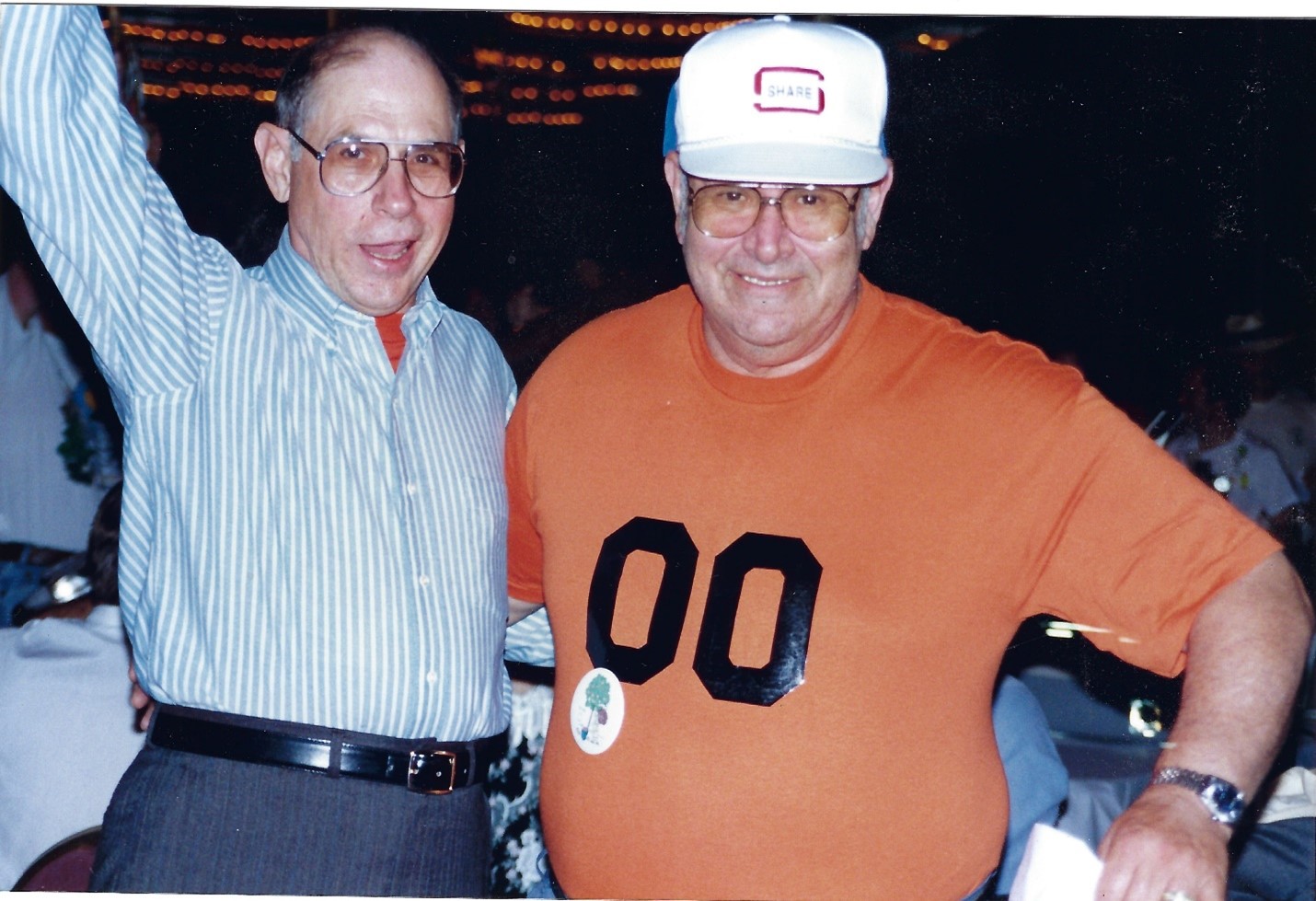 Caption: Dr. Robert Rannie of Northern Illinois University and IBM representative Jerry Feinman
Caption: Dr. Robert Rannie of Northern Illinois University and IBM representative Jerry Feinman
Dr. Rannie remained the steward of the paddles until well after his retirement and kept them in a very nice custom box hand-crafted by IBMer (now retired) John Eells (learn more about him in SHARE’d Intelligence). They were shipped to and from SHARE conferences on several occasions, but it was costly. The paddles are not gone — just the opposite: one of Dr. Rannie’s proteges, who is now a key mainframe educator, and is likewise based at NIU, Geoffrey Decker inherited the stewardship of the paddles from Dr. Rannie. Although he hasn’t yet brought the paddles to a SHARE, he does bring many of his students to our conference.
Decker, Caluori, and many others, including myself, have not merely preserved but persevered in keeping these SHARE cultural items alive and accessible, building and keeping our culture at the Thursday evening reception (SCIDS) and throughout the year. As a new generation of SHARE-ing dawns, perhaps there will be a renewed interest in this history and culture, songs, paddles, etc., and we can hope to have them all back at SHARE before our 75th anniversary.